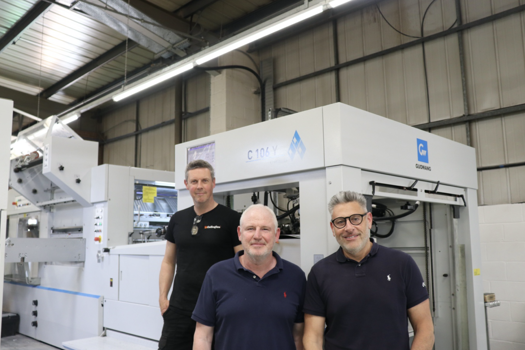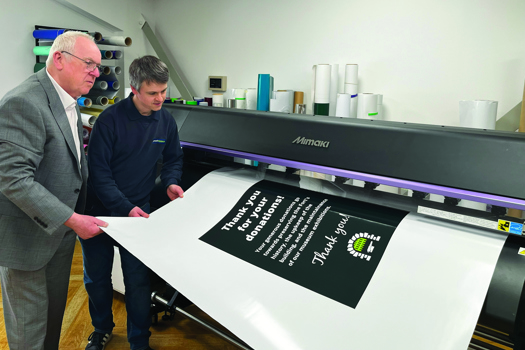What does it do?
This is a B2-plus format sheetfed duplex inkjet press, with CMYK aqueous inks. It can handle offset coated, uncoated and inkjet optimised papers, with Ricoh claiming high quality for applications including commercial printing, direct mail, colour books and personalised packaging.
It’s intended to take over short-run offset work, while offering higher capacity but lower operating costs than dry toner digital presses. Although slower than offset presses, there’s no downtime for plate changes and makeready, and paper can be changed on the fly.
The Z75 name refers to the nominal 750mm maximum sheet length (it will take banners longer than that).
When was it launched and what markets is it aimed at?
Pro Z75 was first announced in 2020. It was delayed by Covid, so it was late 2023 before there was a limited “controlled release” in Japan. It was demonstrated in Europe as a big part of Ricoh’s Drupa stand a year ago, where in keeping with Ricoh’s new animal naming scheme, it was called Dragon and given dramatic wrap graphics. The full sales release started on 1 April this year.
Tim Carter, commercial print director at Ricoh UK Graphic Communications, says: “The Pro Z75 was developed to help commercial printers reach new levels of productivity and image quality, with competitive operating costs. It is positioned to empower commercial printers to transition from short-run offset to profitable high-quality digital inkjet printing.”
So far there are no inline finishing options. However, Ricoh points out that it’s compatible with standard finishing kit developed for B2 litho presses.
Ricoh’s other ‘Pro’ sheetfed digital colour presses, the Pro C7500 and Pro C9500, are long-SRA3 formats that handle substrates from 40-470gsm, compared with the 60-400gsm of the Pro Z75. The Pro C7500 also has a fifth colour station.
The B2-plus format of the Pro Z75 allows larger imposition schemes if needed, and increases throughput with the optional pallet feeder and dual stacker.
How does it work?
It’s a sheetfed inkjet press with inline duplexing that handles sheets of B2-plus. There are two (optionally four) paper feed trays plus the dual output stacker option.
The inkjet print engine uses Ricoh’s own drop-on-demand water-cooled printheads, with 11 heads across the width to give 1,200dpi.
Although it handles offset papers as standard, Ricoh will release an optional Undercoater later this year that it says “may enhance results on some coated and uncoated offset stocks.” It isn’t needed for inkjet coated stocks.
It shares ‘Swing & Shift’ sheet registration technology with Ricoh’s toner presses, with accuracy comparable to an offset press, the company claims. Paper is transferred onto the cylinder drum with grippers, then held by vacuum during printing. An alignment mark printed on each top sheet is detected for front-to-back registration.
There’s an inline scanner for closed-loop quality control. Jet-outs can be detected and compensated for during the run. Printhead cleaning is handled by an automated web and blade system. Drying uses a combination of IR, LED lamps and air knives.
This is a four-colour press but Carter says the print engine has “space for additional rows of printheads and therefore extra colours are a future possibility. However, the inks already offer a broad colour gamut”. Covers-open photographs show room for two more rows.
The standard high-capacity stacker takes about 7,200 sheets, with the optional second stacker allowing unloading without stopping. A tape inserter separates different jobs. A proofing tray on top can deliver small, more urgent jobs.
The Fiery Controller and HyperRIP are common with the Pro C7500 and C9500. The press’ large control touchscreen shows status, paper settings, remaining paper and ink, job queues and status, and the maintenance schedule.
How productive is it?
It runs at 4,500sph simplex or 2,200sph duplex for up to 330gsm weights, and a bit slower for 400gsm. In A4 page per minute terms, that’s about 300ppm, or about twice that of the fastest SRA3 toner presses. It’s rated for 1.7m B2 impressions per month.
What’s the USP?
“The beauty of this press is that it combines offset quality, digital flexibility and inkjet economics,” says Carter. That is why we believe it answers some of the key market and production challenges many PSPs are facing.”
How easy is it to use and learn?
“B2 litho operators will appreciate the familiarity of the B2 format and workflow while users of Ricoh toner presses will immediately recognise the Fiery controller user interface,” says Carter. “While training requirements are much lower than for litho or liquid toner presses, the necessary training is included as part of the installation package.”
What does it cost?
This depends on configuration, but Ricoh says it starts “below a million”. Carter adds “customers generally purchase ink ‘a-la-carte’ and pay a monthly service fee. Inkjet presses offer excellent economics for most use cases. However, it is not easy to directly compare inkjet costs per page, which vary with ink coverage, with those for toner which generally have a flat click charge rate.”
SPECIFICATIONS
Process DoD piezo inkjet
Inks Aqueous, CMYK
Resolution 1,200x1,200dpi
Throughput 4,500sph simplex or 2,200sph duplex for up to 330gsm weights
Max paper size B2-plus (585x750mm)
Paper weight range 115-400gsm uncoated, 80-400gsm coated
Paper feed options Standard two-drawer vacuum feed, with optional second unit
Footprint 12.2x3.9m
Weight 13,500kg
Front end Fiery FS500 Controller and HyperRIP
Output options Heidelberg pallet stacker
Price Under £1m
Contact Ricoh UK, 01604 814900 www.ricoh.co.uk
ALTERNATIVES
The B2 digital press market is burgeoning, with established players and new devices coming to the market.
Fujifilm Jet Press 750S High Speed The original B2 inkjet press, though considerably modified and upgraded over the years. Fujifilm markets it on its print quality and gamut. It uses offset type feed and delivery and does not have inline duplexing. The latest HS model produces 3,600sph in High Quality mode and 5,400sph in High Performance: faster than the Pro Z75, though work-and-turn would be slower.
Fujifilm Revoria GC12500 The first sheetfed B2 toner press, with a 750mm landscape configuration and duplex printing. Shown at Drupa last year, we await details on when it will ship. Print speed is 2,500sph simplex, 1,250sph duplex, and it uses new developments such as two-stage fusing to achieve the required print quality across the width.
Contact Fujifilm UK 0345 0060065 www.fujifilm.eu
HP Indigo 120K HD Latest in the best-selling B2 sheetfed digital press series to date. The liquid toner press costs more than the Ricoh or Fuji inkjets, but offers high quality and wide substrate potential. Announced at Drupa 2024, the 120K replaced the 100K with similar mechanical specs but with more automation and some AI. Speed is 4,500sph simplex, 2,2250sph duplex, or 6,000sph in three-colour EPM mode. The HD version can handle screen rulings up to 250lpi. The lower throughput 18K model has up to seven colour stations.
Contact HP 0800 408 4348 www.hp.com
Konica Minolta AccurioJet 60000 Set to enter beta testing this year, the AccurioJet 60000 is the successor for the KM1 B2 inkjet originally launched at Drupa 2016. The 60000 using the same HS-UV inkjet technology but is double the speed, printing at 6,000sph.
Contact Konica Minolta 01268 534444 www.konicaminolta.co.uk
Komori J-Throne 29 This new B2 LED UV sheetfed inkjet uses Komori’s own tech, unlike its existing Impremia IS29 which is joint venture with Konica Minolta. Print speed is 6,000sph or 3,000sph duplex, and commercial availability is expected this year.
Contact Komori 0113 823 9200 www.komori.eu
Canon varioPress iV7 Canon aims to build on the success of its ix3200 sheetfed inkjet with the B2-plus format iV7. It’s fast, printing at four-colour at 8,700sph simplex, or 4,350sph duplex. Scheduled for commercial launch in Q4. Heidelberg will sell it as the Jetfire 75.
Contact Canon UK 0844 892 0810 www.canon.co.uk
USER REVIEW
“Colour quality and consistency are very important to our partners. And this is where the Ricoh Pro Z75 really excels – even though we do not have professional print operators running the press. That says a lot about the high level of automation of this machine, and its user friendliness.” Bartjan Van Damme, production manager, YourSurprise, Zierikzee, Netherlands










